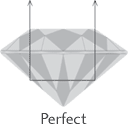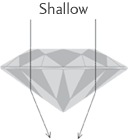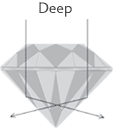-
Your shopping cart is empty!
DIAMOND SHAPE v. DIAMOND CUT
The cut of a diamond can be ambiguous as it refers to both the shape in a general sense and then the actual cut quality or make in a more detailed description. There are many diamond shapes; the most popular is the round brilliant diamond. The round brilliant is the classic diamond shape and contains 58 facets including the culet. The round brilliant shape is the most expensive as it is usually possible to retain more carat size by cutting to fancy shapes than cut to a round. The choice of shape is your personal preference, below are some pictures of different diamond shapes:
DIAMOND CUT The term cut in an accurate sense defines the Diamonds ‘make’, ie. symmetry and dimensions. The diamond’s cut influences its ability to handle light refraction and create sparkle, scintillation and life. When a diamond is well cut the diamond’s facets will be in alignment and allow light to refract within and then disperse through the top of the diamond. With perfect light dispersion comes the beautiful diamond sparkle that every girl dreams of. At ComparetheDiamond.com (formerly diamondgeezer.com) we have created a sparkle factor to assist our shoppers click our link to shop.
DIAMOND SYMMETRY
Diamond symmetry is graded using what appear to be vague adjectives but are in fact precise qualitiy tags:
Ex = Excellent, ID = Ideal
VG = Very GoodG = GoodF = FairP = Poor
A symmetry that maximizes the optimal light return is known as Excellent or Ideal, illustrated as perfect below.

Diamonds with Premium and Very Good symmetry are well cut diamonds and have an abundant sparkle and presence. Good symmetry represents value for money but will not capture all the potential light return but will have a nice sparkle. Fair and Poor cuts should be avoided as they may be too shallow or deep and have a less than satisfactory performance (as illustrated below, shallow/deep).


DIAMOND POLISH
Diamond Polish is also graded like symmetry with what appear to be vague adjectives but are in fact precise quality tags:
Ex = Excellent, ID = Ideal
VG = Very GoodG = GoodF = FairP = Poor
These quality codes define the finished surface of the diamonds facets. A diamond can have different textures and direction of the carbon composition. This means that when polishing a diamonds facets different directional movement and various degrees of coarseness will give a better finish or polish. Diamond polish can be compared to sanding wood, cutting meat or painting; there is a general direction and texture to be observed for excellence. An excellent or very good polish will perform better than a good polish and a fair or poor polish could have noticeable blemish marks and should be avoided. General value and performance can be found with Good to Very Good polish with Excellent/Ideal Polish a premium for the best finish.
HEARTS AND ARROWS
Hearts and Arrows are a visual spectacle within certain diamonds. This pretty pattern was first recognised by the Japanese in the 1980’s using a viewing scope gadget. Viewing hearts and arrows (H & A) patterns in diamonds does not guarantee excellent or ideal symmetry. It is true that perfect hearts and arrows means that facets have been well aligned but there are many different shaped hearts and arrows, simply viewing this phenomenon isn’t proof of a well cut, well proportioned diamond. If the heart is split and not perfectly formed it fails and should the arrow shafts not align with the arrow heads then they too fail.

Very precise analysis is required to ascertain the perfect shape of the hearts and arrows and this must be performed under near microscopic conditions using the novel toylike ‘Hearts and Arrows Scope’. There are 8 hearts and 8 arrows, if any one of these 16 patterns does not perfectly align it is not true H & A. Although nice to have there is a premium attached to the visual ‘bonus’; also note that once the diamond is set in a ring the hearts will no longer be visible. For this reason, if you’re not a collector, investor or a connoisseur focus should be on the reported symmetry ie: Excellent/Ideal, Very Good, Good, Fair, Poor. It’s interesting to note that any cubic zirconia (CZ) which is an artificial synthetic diamond bought for a few cents will almost always show H & A in fact we have marketing paper weights the size of tennis balls that show Hearts and Arrows so don’t be too taken by this cleaver marketing visual.
SUMMARY
In summary it is important to have a quality cut diamond and more emphasis is now placed on excellent and ideal cuts to which there is a premium. Very good symmetry is still a quality diamond and these represent good value and performance. Good symmetry is suitable for shoppers on a tight budget with better carat size and clarity taking preference. A good cut will still sparkle and does represent value although a very good cut is a benchmark to achieve. Fair and Poor cuts should be avoided when possible as they will leak light and be visually unspectacular. Review the cut grades on a reputable diamond certificate; we list all the information on over 200, 000+ diamonds.